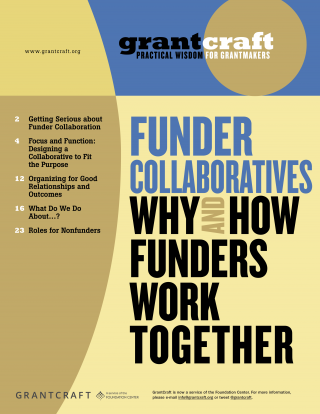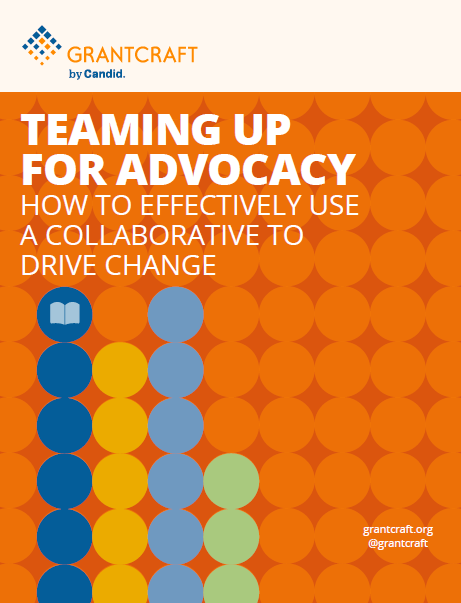Funder Collaboratives Why and How Funders Work Together
When it comes to funder collaboratives, is the whole truly greater than the sum of its parts? Can foundations make a bigger impact with grant dollars by working together than by going it alone? Yes, grantmakers say, as long as members define their goals, set clear operational guidelines, and work from the start to make the collaborative function well for grantees. In this guide, contributors share strategies for structuring a collaborative to fit its purpose, building strong relationships and resolving conflicts, and figuring out if the collaborative you're in is working. Contributors also offer ample proof that collaboratives are leading the field in bringing the voices of nonfunders - grantees, intended beneficiaries, experts, and others - into the process of making grants.
Highlights
- Designing a collaborative to fit the purpose
- Questions to answer at the start
- Benefits and challenges of funder collaboratives
- Three case studies
What's in the Guide?
- Getting Serious about Funder Collaboration: After years of hearing that more collaboration would be a good thing, funders seem to be getting beyond the talk and finding new ways to work together.
- Focus and Function: Designing a Collaborative to Fit the Purpose: A collaborative takes shape when a group of grantmakers recognize that they share a common focus — and that they might be able to do more together than they can on their own. The next step is figuring out how to structure a collaborative to serve the function they have in mind. This section outlines three basic types, with examples of each.
- Organizing for Good Relationships and Outcomes: A collaborative runs on the power of its relationships, which can run a little more cleanly if the group takes time to set some simple ground rules. Yet a certain amount of "messiness" is inevitable in any collaborative venture.
- What Do We Do About…? The beauty of predictable problems is that they can be anticipated, planned for, and perhaps even avoided. In this section, grantmakers share tips about what to do about tensions that arise in many collaboratives: clubbiness, disagreement, and more.
- Roles for Nonfunders: Funder collaboratives have found creative ways to involve nonfunders in their work. When funders make common cause, it seems, it's not such a stretch to include others.

Categories
Content type
Content series
-
Link to Does Size Matter?
Key Ingredients for an Effective and Healthy Funder Collaborative
There are numerous approaches to funder collaboratives in the philanthropic community. From the experience of the Connect U.S. Fund, several ingredients are vital for success.
Read more -
Link to Does Size Matter?
The Benefit of Funder Collaboratives
There are many benefits offered to foundations participating in funder collaboratives, as well as to the fields they are seeking to support. While some of the upsides may be obvious, others are more subtle or unexpected and only emerge after years of experience.
Read more -
Link to Does Size Matter?
Challenges: Funder Testimonials
-
Control - “You don’t always get what you want. Your foundation could be particularly attached to an individual grantee and other people might say, ‘But they’re not doing what we want.’ You have to make compromises. For some foundations, that’s difficult.”
-
-
Link to Does Size Matter?
Roles for Nonfunders
A former foundation president cited a similar experience: “A few years ago, our foundation worked with a number of local nonprofits to create an initiative to end childhood hunger in our city. Every organization — from food banks to foundations — that worked on nutrition issues was at the table, contributing ideas and participating in meetings to figure out what to do. We had committees and groups working on each part of the question. Eventually, we hammered out a plan and then sent that draft around for comment.”
Read more -
Link to Does Size Matter?
Hiring a Staff Intermediary
Many funders believe that collaboratives work best when they have staff or a managing director to keep the trains running and coordinate communication among members.
Read more -
Link to Does Size Matter?
Common Collaboration Problems + Tactics
1. Personality Problems
- Promote open, honest communication.
- Identify people who might have trouble collaborating upfront.
- Link to Does Size Matter?
-
Link to Does Size Matter?
Organizing for Good Relationships and Outcomes
Demonstrate trust and respect for the people you are working with. In a collaborative that explicitly wanted to bring new funders into a field, for example, a grantmaker whose foundation contributed the majority of the initial funding urged the group to equalize voting rights:
Read more -
Link to Does Size Matter?
The “Messiness” of Collaborative Relationships
Many researchers and consultants who study organizational dynamics agree that personal relationships are the seeds of nearly all collaborations and key to fostering success once a collaborative effort is underway.
Read more -
Link to Does Size Matter?
Economic Downturn Impact
The recent economic downturn, for example, has severely diminished the financial resources of philanthropic institutions and the nonprofits they support.
Read more
When it comes to funder collaboratives, is the whole truly greater than the sum of its parts? Can foundations make a bigger impact with grant dollars by working together than by going it alone? Yes, grantmakers say, as long as members define their goals, set clear operational guidelines, and work from the start to make the collaborative function well for grantees. In this guide, contributors share strategies for structuring a collaborative to fit its purpose, building strong relationships and resolving conflicts, and figuring out if the collaborative you're in is working. Contributors also offer ample proof that collaboratives are leading the field in bringing the voices of nonfunders - grantees, intended beneficiaries, experts, and others - into the process of making grants.
Highlights
- Designing a collaborative to fit the purpose
- Questions to answer at the start
- Benefits and challenges of funder collaboratives
- Three case studies
What's in the Guide?
- Getting Serious about Funder Collaboration: After years of hearing that more collaboration would be a good thing, funders seem to be getting beyond the talk and finding new ways to work together.
- Focus and Function: Designing a Collaborative to Fit the Purpose: A collaborative takes shape when a group of grantmakers recognize that they share a common focus — and that they might be able to do more together than they can on their own. The next step is figuring out how to structure a collaborative to serve the function they have in mind. This section outlines three basic types, with examples of each.
- Organizing for Good Relationships and Outcomes: A collaborative runs on the power of its relationships, which can run a little more cleanly if the group takes time to set some simple ground rules. Yet a certain amount of "messiness" is inevitable in any collaborative venture.
- What Do We Do About…? The beauty of predictable problems is that they can be anticipated, planned for, and perhaps even avoided. In this section, grantmakers share tips about what to do about tensions that arise in many collaboratives: clubbiness, disagreement, and more.
- Roles for Nonfunders: Funder collaboratives have found creative ways to involve nonfunders in their work. When funders make common cause, it seems, it's not such a stretch to include others.



